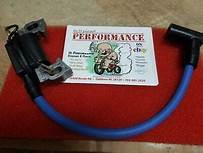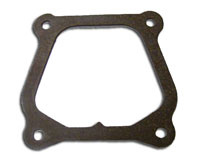busted_blocks
Active member
Hi Everyone,
I'm a relatively new engine builder. Relatively means I've blown up 3 or 4 engines...
My current setup is:
GX200
Decked Block (0.8mm)
Flat top piston
GX160 Head (mildly ported, removed sharp edges and increased bowl size to match 27mm intake valve)
27mm intake
24mm exhaust
Stock Cam
Sheet metal head gasket
Upgraded Valve springs (2.5mm thick wire, let's say 26lb springs)
22mm Carb (PE22)
Cast Aluminum flywheel
Timing advanced an extra12 deg or so.
First time running this setup I had knocking, which I kept thinking was from the valves, and the block cracked. Replaced the block upgraded my gas, then had the connecting rod grenade. Big hole in that block. I think this was due to a used crank shaft with some wear which wore on the connecting rod and increased friction etc.. Replaced the block, piston, crank shaft, connecting rod and ran it again. This time connecting rod was OK but the intake lobe on the cam was beat to heck. Replaced the cam, again beat to heck on the intake lobe. Replaced the valve guides, valves and cam and seems to work OK. Put in some laps on the track (go-kart) maybe 30 minutes in short sessions. I get oil blowing from the valve cover and gas blown out the carb. I put an oil catch can, so that collects the oil, but it's still losing oil to the catch can. I also have gas blowing out the carb. I took apart the engine and cam is OK, connecting rod is OK, oil has no metal in it. I have 1 6mmID hose going from the governor arm hole to the valve cover.
I have a second engine with larger valves, but basically the same setup. I ran it for only 10 minutes or so but it's also blowing gas out the carb. PWK24 flatside carb. It runs awesome, it's a beast, but oil/gas issues seem like I'm missing something.
Any suggestions on things to check/try would be very much appreciated.
I'm a relatively new engine builder. Relatively means I've blown up 3 or 4 engines...
My current setup is:
GX200
Decked Block (0.8mm)
Flat top piston
GX160 Head (mildly ported, removed sharp edges and increased bowl size to match 27mm intake valve)
27mm intake
24mm exhaust
Stock Cam
Sheet metal head gasket
Upgraded Valve springs (2.5mm thick wire, let's say 26lb springs)
22mm Carb (PE22)
Cast Aluminum flywheel
Timing advanced an extra12 deg or so.
First time running this setup I had knocking, which I kept thinking was from the valves, and the block cracked. Replaced the block upgraded my gas, then had the connecting rod grenade. Big hole in that block. I think this was due to a used crank shaft with some wear which wore on the connecting rod and increased friction etc.. Replaced the block, piston, crank shaft, connecting rod and ran it again. This time connecting rod was OK but the intake lobe on the cam was beat to heck. Replaced the cam, again beat to heck on the intake lobe. Replaced the valve guides, valves and cam and seems to work OK. Put in some laps on the track (go-kart) maybe 30 minutes in short sessions. I get oil blowing from the valve cover and gas blown out the carb. I put an oil catch can, so that collects the oil, but it's still losing oil to the catch can. I also have gas blowing out the carb. I took apart the engine and cam is OK, connecting rod is OK, oil has no metal in it. I have 1 6mmID hose going from the governor arm hole to the valve cover.
I have a second engine with larger valves, but basically the same setup. I ran it for only 10 minutes or so but it's also blowing gas out the carb. PWK24 flatside carb. It runs awesome, it's a beast, but oil/gas issues seem like I'm missing something.
Any suggestions on things to check/try would be very much appreciated.




































